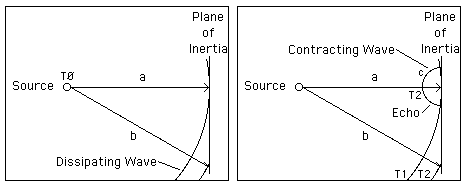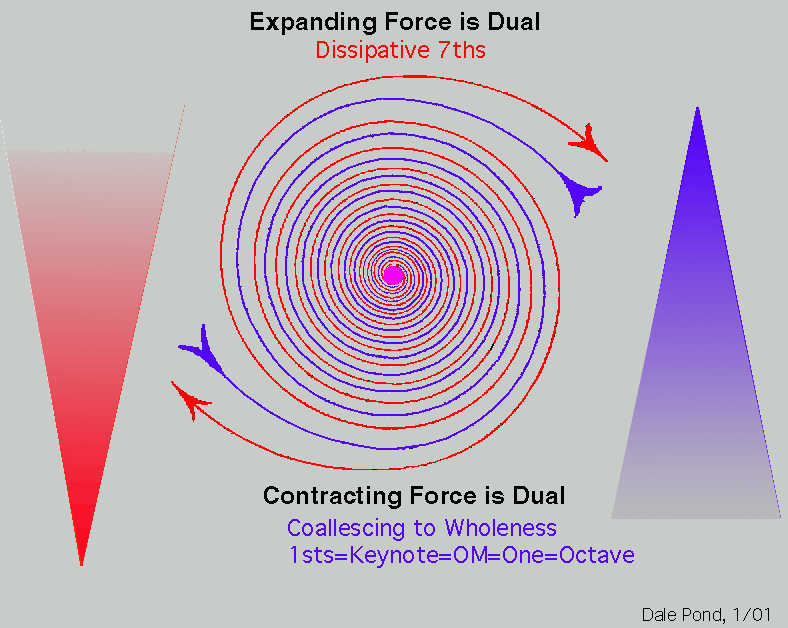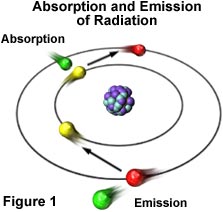The SVP Universal Cosmology
A Rosetta Stone for the New Science Paradigm
Version 1.0
Polarity Manifests as Rotating Vortex
|
|
 |
|
|
Figure 3.3 - Vector
Potentials
|
|
Figure 3.4 - Vector
Polarizations
|
|
Figure 3.5 - Introductory Affinitizing
to Center
|
|
Figure 3.6 - Beginning of Vortex
Motions
 |
b reaches and impacts PoI at T2.
b voids and reverses polarity.
|
|
Figure 3.8 - Celestial Seeks and
Condenses at Center
|
|
"All dimensions simultaneously expand and contract in opposite directions of the same ratio.
Expansion pressure is in direct ratio to the square of the distance,
area, plane, orbit or time unit, and to the cube of the volume.
Contraction pressure is in inverse ratio to the square of the distance,
area, plane orbit or time unit, and to the cube of the volume." (The Universal One, pg 162)
"Every mass in the universe occupies a measurable potential position." (The Universal One, pg 162)
"Every
generative effect of motion begins its cycle at its maximum in the
region of lowest pressure, loses one half of every dimension of it at
the high pressure point of its cycle wave, and exhausts its effect at
the place of its beginning.
Every radiative effect of motion begins
its cycle at its minimum in the region of the lowest pressure, gains
one-half of every dimension of it at the high pressure point of its
cycle wave, and attains its maximum at the place of its ending." (Genero-Radiative Concept, part 6b)
The vortex theory
assumes, therefore, that the universe consists of one uniform
primary substance, a fluid which fills all space, and that what
we call matter consists of portions of this fluid which have
become animated with vortex motion. The innumerable atoms which
form molecules, and through molecules all the diversified forms
of matter of the material universe, are therefore simply so
many vortex rings, each perfectly limited, distinct, and
indestructible, both as to its form, mass, and mode of motion.
They cannot change or disappear, nor can they be formed
spontaneously. Those of the same kind are constituted after the
same fashion, and therefore are endowed with the same
properties.
The theory is a plausible
one, and the reputation of its authors must command for it
respectful consideration; but it is as yet a long way from
being an established theory which can be accepted as a true
representation of facts. In the first place it is based solely
on mathematical theory, and not, as in the case of atoms and
light-waves, upon actual facts of weight and measurement tested
by experiment, and to which mathematical reasoning affords only
an aid and supplement. No one has proved the existence of such
a medium or of such vortex rings, much less weighed or measured
them.
Moreover the theory is open
to some very obvious objections. How can aggregations of
imponderable matter acquire weight, and become subject to the
law of gravity, which, as we have seen, is one of the essential
and permanent qualities of atoms? If a cubic millionth of a
millimeter of ether formed into a big vortex ring of, say, an
atom of mercury, has a weight equal to 200 times that of an
atom of hydrogen, which itself has a definite weight, why has
it no weight in its original form? And if it had weight,
however small, how could the enormous mass of ether filling all
space produce no perceptible effect on bodies, even of
attenuated cometic vapor, revolving through it with immense
velocities? Again, how could these innumerable vortex rings be
formed out of the ether without disturbing the uniformity and
continuity of the medium, which are essential for the
propagation of the light-waves through it? And how could the
motions requisite to form the vortex rings be impressed on the
them de novo consistently with the principle of the
conservation of energy? Energy can no more be created out of
nothing than matter, by any process known in nature or
conceivable by the human intellect; and to assume it is simply
a more refined manner of falling back on the superatural, which
is itself only a more refined manner of saying that we know
nothing.
For the present, therefore,
we must be content with atoms and ether as the ultimate terms
or our knowledge of the material or quasi-material components
of the universe." [A Modern Zoroastrian; Laing, Stephen;
Chapman and Hall, London, 1891]
References: Col. Thomas Bearden: I'll give you several of them that bear directly on this. See R. Chen, "Cancellation of internal forces," American Journal of Physics, Vol. 49, No. 4, Apr. 1981, p. 372. Chen gives a discussion of these summation vectors and internal vectors. He points out that the internal forces occur in equal and opposite pairs; in other words, as internal stresses. That's certainly pointing out the internal, bidirectional force structure of a scalar stress - a scalar potential, if we're talking EM stress and EM forces. Note that this internal pattern is exactly what Maxwell's quaternion theory captured and retained, and that the Heaviside and Gibbs vector theory discards. Further, the quaternions captured the internal order of this internal force vector structure as well. Second, in a beautiful article Kidd bluntly states that all our measurement/detection is really binocular. See Richard Kidd et al, "Evolution of the modern photon," American Journal of Physics, Vol. 57, No. 1, Jan. 1989, p. 27-35. E.T. Whittaker, of course, wrote the definitive engineering methodology of how to do all this with EM waves - how to infold the EM waves into a bidirectional wave structure that produces a standing wave of externally force-field-free scalar potential. The two Whittaker papers are (1) "On the partial differential equations of mathematical physics," Mathematische Annalen, Vol. 57, 1903, p. 333-355; and (2) "On an expression of the electromagnetic field due to electrons by means of two scalar potential functions," Proc. Lond. Math. Soc., Series 2, Vol. 1, 1904, p. 367-372.
See also Russell's "Principle of Regeneration".|
|
|
|
Figure 3.11 - Electric and Magnetic
Vectors
|
|
Figure 3.12 - Mutually Antagonized
Polarities

|
Figure 3.13 - Contracting and Expanding
Duality
 |
